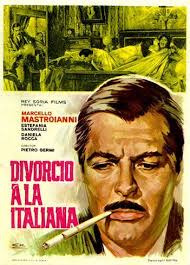"Divorce Italian Style"/"Divorzio Al La Italiana", Dir: Pietro Germi, 1961
- Ravi Swami
- Jan 23, 2021
- 4 min read
Updated: May 23, 2022
"I Knew Her Well" put me on the trail of more films by Antonio Pietrangeli and also starring Stefania Sandrelli but I quickly discovered that they are thin on the ground on most streaming services, though Bernardo Bertolucci's "The Conformist" is available on Amazon Prime, requiring signing up, which I didn't really want to do at this stage, though it is now available for rent on YouTube for a very fair 99 pence - as for Pietrangeli, hopefully we'll see more of his films becoming available in the near future.
Much the same situation exists for films starring Stefania Sandrelli with again The Criterion Collection delivering two of her early screen appearances - along with interviews and screen-test footage - of which "Divorce Italian Style" is one, her film debut, and where, despite being only 14 years of age, she delivers a remarkably mature performance.
The film is easier to categorize as an example of the "Comedia All'Italiana" genre described in the previous post on "I Knew Her Well", being a black comedy very much in the vein of the British Ealing Comedy classic "Kind Hearts and Coronets", made over a decade previously in 1949, a comparison that may unfairly imply that the film is inspired by its predecessor and after watching it the comparisons are inescapable, however, it's a testament to the skill of the writer and director Germi that this comparison is never obvious.
Super-smooth Italian heartthrob Marcello Mastroianni plays "Ferdinando Cefalù", the son of an impoverished Sicilian nobleman living in a once grand but now decrepit equivalent of an English stately home in the Italian provinces, and in a manner similar to "Kind Hearts & Coronets" the film takes the form of a flashback with Ferdinando present throughout as a voice-over recounting events that took place earlier on.
Ferdinando is unhappily married to Rosalia (Daniela Rocca) - whose appearance would suggest, perhaps unfairly, that all spurned wives in Italian comedies must have moustaches and a "uni-brow" - and lives in an annex of the villa - the result of his father's squandering of the family wealth - and includes his attractive 18 year old cousin, Angela (Stefania Sandrelli) and her parents.
To fend off Rosalia's frustrated ardour in the bedroom, Ferdinando takes refuge in the bathroom, which conveniently has a window overlooking a courtyard and across into Angela's bedroom and from which he watches her obsessively, an activity shared, without his knowledge, by his lecherous father.
He pursues Angela relentlessly in secret, and after one particularly intense encounter while at the beach, she declares her love for Ferdinando in her diary, the discovery of which by her father leads to her being sent away for her education after he accuses her of having a
lover and heaping further shame on their family - Ferdinando at this point is in his late 30's and Angela, 18.
The love-sick and unsatisfied Ferdinando concocts a plan to remove Rosalia by taking advantage of an archaic point of law in Italian marriages where proof of adultery can lead to justifiable homicide by the injured party but would also incur a 4 year prison sentence, something that Ferdinando reasons would make him 40 and Angela in her early 20's, allowing for a more socially acceptable union.
Of course, this being a comedy, the plan backfires in spectacular fashion - yes, Ferdinando has to serve a jail sentence like Dennis Price's character in "Kind Hearts & Coronets" but he avoids the noose (the death count in "Kind Hearts" is considerably higher) and is released to marry Angela with the bonus of his family honour being restored in his home town. It doesn't quite end there though and to avoid spoilers you will have to watch the film to find out what happens next.
The memorable highlight of "Kind Hearts & Coronets" and possibly the reason for its' enduring appeal is the comedy turn by Alec Guinness playing several members of the D'Ascoyne family (who, it should be pointed out have some Italian lineage), and while this element could not easily have been replicated in "Divorce Italian Style" the characterful faces of the "great unwashed" of Fernando's ancestral town more than compensate and add rich detail.
Another key difference is in the obvious studio-bound "drawing room comedy" nature of the earlier film, possibly imposed by wartime restrictions on film-making but where Ealing Studios made full use of the skills of scenic art direction to compensate for the lack of location shooting, aided by a period setting and costumes, whereas this film is set more or less in the present day (of the 1960's), with only the frozen in time, faded grandeur of Ferdinando's family referring to that of the D'Ascoyne's.
In contrast, Germi opens out his film by placing the picturesque locations of the town centre stage, from the baroque church where Ferdinando shoots furtive glances at Angela during services, to the winding cobbled streets lined by sparse sun-baked Italian provincial architecture.
A fun touch is a scene where the townsfolk flock to see Fellini's "La Dolce Vita" (1960), primarily to ogle at Anita Ekberg, a film denounced as being immoral by the local pastor and which of course also starred Mastroianni, a self-referential detail that mimics the French New Wave tendency for the same.
Mastroianni displays a gift for comedy that he brought to bear on other "Comedia All'Italiana" films, as the suave, brilliantined Ferdinando and again Stefania Sandrelli delivers a startlingly mature performance as Angela, something she repeated in "Seduced and Abandoned" (1963), also for Pietro Germi and which is also available on Criterion Channel.
"Divorce Italian Style", Dir: Pietro Germi, 1961
Criterion Channel








Comments